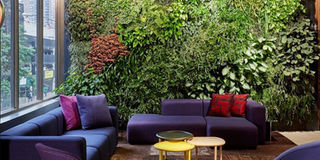Bring your home to life with living walls

What you need to know:
- In areas with no allowance for gardens such as apartments or commercial buildings, these walls provide the advantage of improved air quality by absorbing toxins such as formaldehyde or carbon monoxide within the home.
Living walls combine effortless style and nature to revitalise a space. Whether indoors or outdoors, installing a vertical garden against an existing wall can invite a calming, serene effect, transforming your home or workspace with a touch of greenery.
In areas with no allowance for gardens such as apartments or commercial buildings, these walls provide the advantage of improved air quality by absorbing toxins such as formaldehyde or carbon monoxide within the home.
Living walls have also been known to elevate one’s mood, encourage a bio diverse urban environment and even lower noise pollution within a space by acting as an insulator.
For lovers of the environment with minimal space for gardening, living walls are a great way to enhance the biodiversity of the home, a foray into sustainable living and an eye-catching feature for residents and guests alike.
Kitchen aficionados with a green thumb may also consider planting their own herbs and vegetables along a living wall.
Depending on the size of the home or workspace and personal preference, the style of this wall can morph to suit different functions. With numerous advantages and a concept that goes back to basics, living walls are fast becoming a decor staple that can breathe new life into a man-made environment.
Here are a few tips on how to construct your own nook of nature:
Location
Be sure to choose an area that receives enough natural light, preferably facing a window, as the light aides in the process of photosynthesis.
The process uses light energy to convert water, minerals and carbon dioxide into oxygen, which then rids the air of pollutants and maintains the lush green allure of the living wall. If lighting is limited in the home, consider using plants that typically thrive in areas with minimal light, or incorporate light fixtures to achieve the same effect.
Plant options
Depending on the look you are going for, the option to mix and match or use one plant for a uniform look is dependent on your vision for the wall.
Different hues and textures can bring forth a more accented wall, but the key is to find plants with similar care conditions such as light, water and temperature.
Vegetables such as tomatoes can serve as ornamental plants, as the requirement for vertical gardens of this kind often leans towards vine-like, leafy varieties that can populate a wall or metal frame.
A widely recognised plant for living walls is the pothos, also known as Devil’s Ivy. It is also important to ensure that the plant can thrive in the specific climate in your area.
How to mount your plants
Play around with different designs and options as you organise your living wall.
Angled planters are a simple way to make a statement, while a variety of frames ranging from wooden to metal designs will provide sufficient support to the plants and allow for better maintenance.
Use old picture frames and chicken coop wires to create a more compact version of a living wall, or incorporate LED grow lights for a warm, modern take on the concept.
Maintenance
As with any green project, keeping the plants at their best is the difficult but most rewarding part of the process. For a more hands-off approach, a self-watering system would go a long way in ensuring the plants are at their greenest. Should you choose to water the plants yourself, be careful not to over or underwater the plants as it could be detrimental to the overall health of the wall. Regular trimming and pruning is also paramount. Clean the wall to avoid the growth of unfavourable foliage.




